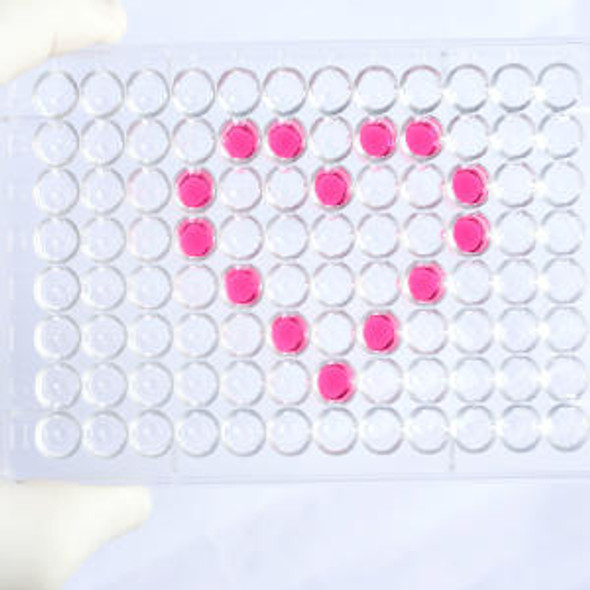Mouse 5'-AMP-activated protein kinase catalytic subunit alpha-2 (Prkaa2) ELISA Kit
- SKU:
- MOEB0735
- Product Type:
- ELISA Kit
- Size:
- 96 Assays
- Uniprot:
- Q8BRK8
- ELISA Type:
- Sandwich
- Reactivity:
- Mouse
Description
| Product Name: | Mouse 5'-AMP-activated protein kinase catalytic subunit alpha-2 (Prkaa2) ELISA Kit |
| Product Code: | MOEB0735 |
| Alias: | 5'-AMP-activated protein kinase catalytic subunit alpha-2, AMPK subunit alpha-2, Prkaa2, 2.7.11.1, Acetyl-CoA carboxylase kinase, ACACA kinase, 2.7.11.27, Hydroxymethylglutaryl-CoA reductase kinase, HMGCR kinase, 2.7.11.31 |
| Uniprot: | Q8BRK8 |
| Reactivity: | Mouse |
| Range: | Please contact us for more information |
| Detection Method: | Sandwich |
| Size: | 96 Assay |
| Storage: | Please see kit components below for exact storage details |
| Note: | For research use only |
| UniProt Protein Function: | AMPKA2: a catalytic subunit of AMP-activated protein kinase (AMPK). Acts as an energy sensor, playing a key role in regulating cellular energy metabolism. A protein kinase of the CAMKL family whose activation is regulated by the balance between ADP/AMP/ATP, and intracellular Ca(2+) levels. Acts as a metabolic stress-sensing protein kinase switching off biosynthetic pathways when cellular ATP levels are depleted and when 5'-ADP and -AMP rise in response to fuel limitation and/or hypoxia. Activates energy-producing pathways and inhibits energy-consuming processes. Restores ATP levels in cells by switching off anabolic and switching on catabolic pathways. Activated primarily by rising ADP levels and not, as previously thought, solely by AMP. AMPK resembles an adenylate charge regulatory system in which anabolic and catabolic pathways are regulated by adenine nucleotide ratios. Acts via direct phosphorylation of metabolic enzymes and transcription regulators. Regulates fatty acid synthesis by phosphorylating acetyl-CoA carboxylase. Regulates cholesterol synthesis by phosphorylating and inactivating hormone-sensitive lipase and hydroxymethylglutaryl-CoA reductase. Activated by at least two distinct upstream kinases: the tumor suppressor LKB1 and CaMKK2. Also acts as a regulator of cellular polarity by remodeling the actin cytoskeleton, probably by indirectly activating myosin. AMPK is a heterotrimer of an alpha catalytic subunit (AMPKA1 or -2), a beta (AMPKB1 or -2) and a gamma non-catalytic subunit (AMPKG1, -2 or -3). Different possible combinations of subunits give rise to 12 different holoenzymes. Binding of ADP or AMP to non-catalytic gamma subunit (PRKAG1, -2 or -3) results in allosteric activation. AMPK is activated by antihyperglycemic drug metformin, a drug prescribed to patients with type 2 diabetes: in vivo, metformin seems to mainly inhibit liver gluconeogenesis. However, metformin can be used to activate AMPK in muscle and other cells in culture or ex vivo. Selectively inhibited by compound C (6-[4-(2-Piperidin-1-yl-ethoxy)-phenyl)]-3-pyridin-4-yl-pyyrazolo[1,5-a] pyrimidine. Activated by resveratrol, a natural polyphenol present in red wine, and S17834, a synthetic polyphenol. Salicylate/aspirin directly activates kinase activity. Studies in the mouse suggest that AMPK2 may control whole-body insulin sensitivity and is necessary for maintaining myocardial energy homeostasis during ischemia.Protein type: Protein kinase, Ser/Thr (non-receptor); EC 2.7.11.27; EC 2.7.11.1; Kinase, protein; Autophagy; Protein kinase, CAMK; EC 2.7.11.31; CAMK group; CAMKL family; AMPK subfamilyChromosomal Location of Human Ortholog: 1p31Cellular Component: nucleoplasm; cytosolMolecular Function: AMP-activated protein kinase activity; protein serine/threonine kinase activity; protein binding; metal ion binding; [acetyl-CoA carboxylase] kinase activity; protein serine/threonine/tyrosine kinase activity; chromatin binding; histone serine kinase activity; ATP binding; protein kinase activity; [hydroxymethylglutaryl-CoA reductase (NADPH)] kinase activityBiological Process: lipid biosynthetic process; rhythmic process; cellular lipid metabolic process; carnitine shuttle; glucose homeostasis; signal transduction; protein amino acid phosphorylation; cellular response to glucose starvation; cellular response to nutrient levels; regulation of fatty acid biosynthetic process; regulation of transcription, DNA-dependent; response to stress; cell cycle arrest; positive regulation of autophagy; fatty acid biosynthetic process; mitochondrion organization and biogenesis; negative regulation of TOR signaling pathway; Wnt receptor signaling pathway; transcription, DNA-dependent; organelle organization and biogenesis; regulation of circadian rhythm; cholesterol biosynthetic process; fatty acid homeostasis; positive regulation of glycolysis; insulin receptor signaling pathway; energy reserve metabolic process; autophagy; negative regulation of apoptosis |
| UniProt Protein Details: | |
| NCBI Summary: | |
| UniProt Code: | Q8BRK8 |
| NCBI GenInfo Identifier: | 46877068 |
| NCBI Gene ID: | 5563 |
| NCBI Accession: | NP_006243 |
| UniProt Secondary Accession: | Q8BRK8,Q9H1E8, Q9UD43 |
| UniProt Related Accession: | Q8BRK8,P54646, AAB32732 |
| Molecular Weight: | 62,320 Da |
| NCBI Full Name: | 5'-AMP-activated protein kinase catalytic subunit alpha-2 |
| NCBI Synonym Full Names: | protein kinase, AMP-activated, alpha 2 catalytic subunit |
| NCBI Official Symbol: | PRKAA2 |
| NCBI Official Synonym Symbols: | AMPK; AMPK2; PRKAA; AMPKa2 |
| NCBI Protein Information: | 5'-AMP-activated protein kinase catalytic subunit alpha-2; 5'-AMP-activated protein kinase, catalytic alpha-2 chain; ACACA kinase; AMP-activated protein kinase alpha-2 subunit variant 2; AMP-activated protein kinase alpha-2 subunit variant 3; AMPK alpha 2 |
| UniProt Protein Name: | 5'-AMP-activated protein kinase catalytic subunit alpha-2 |
| UniProt Synonym Protein Names: | Acetyl-CoA carboxylase kinase (EC:2.7.11.27); ACACA kinase; Hydroxymethylglutaryl-CoA reductase kinase (EC:2.7.11.31); HMGCR kinase |
| Protein Family: | |
| UniProt Gene Name: | PRKAA2 |
| UniProt Entry Name: | AAPK2_HUMAN |
| Component | Quantity (96 Assays) | Storage |
| ELISA Microplate (Dismountable) | 8×12 strips | -20°C |
| Lyophilized Standard | 2 | -20°C |
| Sample Diluent | 20ml | -20°C |
| Assay Diluent A | 10mL | -20°C |
| Assay Diluent B | 10mL | -20°C |
| Detection Reagent A | 120µL | -20°C |
| Detection Reagent B | 120µL | -20°C |
| Wash Buffer | 30mL | 4°C |
| Substrate | 10mL | 4°C |
| Stop Solution | 10mL | 4°C |
| Plate Sealer | 5 | - |
Other materials and equipment required:
- Microplate reader with 450 nm wavelength filter
- Multichannel Pipette, Pipette, microcentrifuge tubes and disposable pipette tips
- Incubator
- Deionized or distilled water
- Absorbent paper
- Buffer resevoir
*Note: The below protocol is a sample protocol. Protocols are specific to each batch/lot. For the correct instructions please follow the protocol included in your kit.
Allow all reagents to reach room temperature (Please do not dissolve the reagents at 37°C directly). All the reagents should be mixed thoroughly by gently swirling before pipetting. Avoid foaming. Keep appropriate numbers of strips for 1 experiment and remove extra strips from microtiter plate. Removed strips should be resealed and stored at -20°C until the kits expiry date. Prepare all reagents, working standards and samples as directed in the previous sections. Please predict the concentration before assaying. If values for these are not within the range of the standard curve, users must determine the optimal sample dilutions for their experiments. We recommend running all samples in duplicate.
| Step | |
| 1. | Add Sample: Add 100µL of Standard, Blank, or Sample per well. The blank well is added with Sample diluent. Solutions are added to the bottom of micro ELISA plate well, avoid inside wall touching and foaming as possible. Mix it gently. Cover the plate with sealer we provided. Incubate for 120 minutes at 37°C. |
| 2. | Remove the liquid from each well, don't wash. Add 100µL of Detection Reagent A working solution to each well. Cover with the Plate sealer. Gently tap the plate to ensure thorough mixing. Incubate for 1 hour at 37°C. Note: if Detection Reagent A appears cloudy warm to room temperature until solution is uniform. |
| 3. | Aspirate each well and wash, repeating the process three times. Wash by filling each well with Wash Buffer (approximately 400µL) (a squirt bottle, multi-channel pipette,manifold dispenser or automated washer are needed). Complete removal of liquid at each step is essential. After the last wash, completely remove remaining Wash Buffer by aspirating or decanting. Invert the plate and pat it against thick clean absorbent paper. |
| 4. | Add 100µL of Detection Reagent B working solution to each well. Cover with the Plate sealer. Incubate for 60 minutes at 37°C. |
| 5. | Repeat the wash process for five times as conducted in step 3. |
| 6. | Add 90µL of Substrate Solution to each well. Cover with a new Plate sealer and incubate for 10-20 minutes at 37°C. Protect the plate from light. The reaction time can be shortened or extended according to the actual color change, but this should not exceed more than 30 minutes. When apparent gradient appears in standard wells, user should terminatethe reaction. |
| 7. | Add 50µL of Stop Solution to each well. If color change does not appear uniform, gently tap the plate to ensure thorough mixing. |
| 8. | Determine the optical density (OD value) of each well at once, using a micro-plate reader set to 450 nm. User should open the micro-plate reader in advance, preheat the instrument, and set the testing parameters. |
| 9. | After experiment, store all reagents according to the specified storage temperature respectively until their expiry. |
When carrying out an ELISA assay it is important to prepare your samples in order to achieve the best possible results. Below we have a list of procedures for the preparation of samples for different sample types.
| Sample Type | Protocol |
| Serum | If using serum separator tubes, allow samples to clot for 30 minutes at room temperature. Centrifuge for 10 minutes at 1,000x g. Collect the serum fraction and assay promptly or aliquot and store the samples at -80°C. Avoid multiple freeze-thaw cycles. If serum separator tubes are not being used, allow samples to clot overnight at 2-8°C. Centrifuge for 10 minutes at 1,000x g. Remove serum and assay promptly or aliquot and store the samples at -80°C. Avoid multiple freeze-thaw cycles. |
| Plasma | Collect plasma using EDTA or heparin as an anticoagulant. Centrifuge samples at 4°C for 15 mins at 1000 × g within 30 mins of collection. Collect the plasma fraction and assay promptly or aliquot and store the samples at -80°C. Avoid multiple freeze-thaw cycles. Note: Over haemolysed samples are not suitable for use with this kit. |
| Urine & Cerebrospinal Fluid | Collect the urine (mid-stream) in a sterile container, centrifuge for 20 mins at 2000-3000 rpm. Remove supernatant and assay immediately. If any precipitation is detected, repeat the centrifugation step. A similar protocol can be used for cerebrospinal fluid. |
| Cell culture supernatant | Collect the cell culture media by pipette, followed by centrifugation at 4°C for 20 mins at 1500 rpm. Collect the clear supernatant and assay immediately. |
| Cell lysates | Solubilize cells in lysis buffer and allow to sit on ice for 30 minutes. Centrifuge tubes at 14,000 x g for 5 minutes to remove insoluble material. Aliquot the supernatant into a new tube and discard the remaining whole cell extract. Quantify total protein concentration using a total protein assay. Assay immediately or aliquot and store at ≤ -20 °C. |
| Tissue homogenates | The preparation of tissue homogenates will vary depending upon tissue type. Rinse tissue with 1X PBS to remove excess blood & homogenize in 20ml of 1X PBS (including protease inhibitors) and store overnight at ≤ -20°C. Two freeze-thaw cycles are required to break the cell membranes. To further disrupt the cell membranes you can sonicate the samples. Centrifuge homogenates for 5 mins at 5000xg. Remove the supernatant and assay immediately or aliquot and store at -20°C or -80°C. |
| Tissue lysates | Rinse tissue with PBS, cut into 1-2 mm pieces, and homogenize with a tissue homogenizer in PBS. Add an equal volume of RIPA buffer containing protease inhibitors and lyse tissues at room temperature for 30 minutes with gentle agitation. Centrifuge to remove debris. Quantify total protein concentration using a total protein assay. Assay immediately or aliquot and store at ≤ -20 °C. |
| Breast Milk | Collect milk samples and centrifuge at 10,000 x g for 60 min at 4°C. Aliquot the supernatant and assay. For long term use, store samples at -80°C. Minimize freeze/thaw cycles. |










